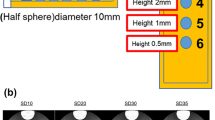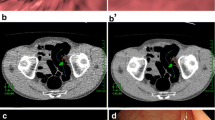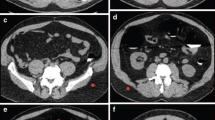Abstract
Objectives
To assess the feasibility of ultra-low dose computed tomography colonography (CTC) using knowledge-based iterative reconstruction (IR) and to determine its effect on polyp detection.
Methods
Forty-nine prospectively-enrolled patients underwent ultra-low dose CTC in the supine (100 kVp/20 mAs) and prone positions (80 kVp/20 mAs), followed by same-day colonoscopy. Thereafter, images were reconstructed using filtered back projection (FBP) and knowledge-based IR (IMR; Philips Healthcare, Best, Netherlands) algorithms. Effective radiation dose of CTC was recorded. Pooled per-polyp sensitivity and positive predictive value of three radiologists was analysed and compared between FBP and IMR. Image quality was assessed on a five-point scale and image noise was recorded using standard deviations.
Results
Mean effective radiation dose of ultra-low dose CTC was 0.90 ± 0.06 mSv. Eighty-nine polyps were detected on colonoscopy (mean, 8.5 ± 4.7 mm). The pooled per-polyp sensitivity for polyps 6.0-9.9 mm (n = 22) on CTC reconstructed with IMR (36/66, 54.5%) was not significantly different with that using FBP algorithm (34/66, 51.5%) (p = 0.414). For polyps ≥10 mm (n = 35), however, the pooled per-polyp sensitivity on CTC with IMR (73/105, 69.5%) was significantly higher than that with FBP (55/105, 52.4%) (p < 0.001). In particular, the difference of per-polyp sensitivity was statistically significant in intermediate (p = 0.014) and novice (p = 0.003) reviewers. Furthermore, mean image noise of IMR (8.4 ± 6.2 HU) was significantly lower than that of FBP (37.5 ± 13.9 HU) (p < 0.001) and image quality with IMR was significantly better than with FBP in all evaluated segments in all reviewers (all ps < 0.001).
Conclusions
Sub-mSv CTC reconstructed with IMR was feasible for the detection of clinically significant polyps, demonstrating 70% per-polyp sensitivity of polyps ≥10 mm, while allowing significant noise reduction and improvement in image quality compared with FBP reconstruction.
Key Points
• Sub-mSv CTC using IMR demonstrated 70% per-polyp sensitivity for polyps ≥10 mm.
• CTC using IMR significantly outperformed CTC reconstructed with FBP.
• IMR allows significantly more noise reduction and improvement in image quality than FBP.





Similar content being viewed by others
Abbreviations
- CTC :
-
Computed tomography colonography
- FBP :
-
Filtered back projection
- IMR :
-
Iterative model reconstruction
- IR :
-
Iterative reconstruction
References
Johnson CD, Chen M-H, Toledano AY et al (2008) Accuracy of CT colonography for detection of large adenomas and cancers. N Engl J Med 359:1207–1217
Levin B, Lieberman DA, McFarland B et al (2008) Screening and surveillance for the early detection of colorectal cancer and adenomatous polyps, 2008: a joint guideline from the American Cancer Society, the US Multi-Society Task Force on Colorectal Cancer, and the American College of Radiology. CA Cancer J Clin 58:130–160
Park SH, Yee J, Kim SH et al (2007) Fundamental elements for successful performance of CT colonography (virtual colonoscopy). Korean J Radiol 8:264–275
Chung SY, Park SH, Lee SS et al (2012) Comparison between CT colonography and double-contrast barium enema for colonic evaluation in patients with renal insufficiency. Korean J Radiol 13:290–299
Angtuaco TL, Banaad-Omiotek GD, Howden CW (2001) Differing attitudes toward virtual and conventional colonoscopy for colorectal cancer screening: surveys among primary care physicians and potential patients. Am J Gastroenterol 96:887–893
Gluecker TM, Johnson CD, Harmsen WS et al (2003) Colorectal cancer screening with CT colonography, colonoscopy, and double-contrast barium enema examination: prospective assessment of patient perceptions and preferences. Radiology 227:378–384
Iannaccone R, Catalano C, Mangiapane F et al (2005) Colorectal polyps: detection with low-dose multi-detector row helical CT colonography versus two sequential colonoscopies. Radiology 237:927–937
Cohnen M, Vogt C, Beck A et al (2004) Feasibility of MDCT Colonography in ultra-low-dose technique in the detection of colorectal lesions: comparison with high-resolution video colonoscopy. AJR Am J Roentgenol 183:1355–1359
Shin C-I, Kim SH, Lee ES et al (2014) Ultra-low peak voltage CT colonography: effect of iterative reconstruction algorithms on performance of radiologists who use anthropomorphic colonic phantoms. Radiology 273:759–771
Flicek KT, Hara AK, Silva AC et al (2010) Reducing the radiation dose for CT colonography using adaptive statistical iterative reconstruction: a pilot study. AJR Am J Roentgenol 195:126–131
Fletcher JG, Grant KL, Fidler JL et al (2012) Validation of dual-source single-tube reconstruction as a method to obtain half-dose images to evaluate radiation dose and noise reduction: phantom and human assessment using CT colonography and sinogram-affirmed iterative reconstruction (SAFIRE). J Comput Assist Tomogr 36:560–569
Nagata K, Fujiwara M, Kanazawa H et al (2015) Evaluation of dose reduction and image quality in CT colonography: comparison of low-dose CT with iterative reconstruction and routine-dose CT with filtered back projection. Eur Radiol 25:221–229
Willemink MJ, de Jong PA, Leiner T et al (2013) Iterative reconstruction techniques for computed tomography Part 1: technical principles. Eur Radiol 23:1623–1631
Yoon MA, Kim SH, Lee JM et al (2012) Adaptive statistical iterative reconstruction and Veo: assessment of image quality and diagnostic performance in CT colonography at various radiation doses. J Comput Assist Tomogr 36:596–601
Mehta D, Thompson R, Morton T, Dhanantwari A, Shefer E (2013) Iterative model reconstruction: simultaneously lowered computed tomography radiation dose and improved image quality. Med Phys Int J 2:147–155
Bongartz G, Golding S, Jurik A et al (2004) European guidelines for multislice computed tomography. European Commission, Luxembourg
Kim SH, Lee JM, Shin CI et al (2008) Effects of spatial resolution and tube current on computer-aided detection of polyps on CT colonographic images: phantom study. Radiology 248:492–503
Shin CI, Kim SH, Im JP et al (2016) One-mSv CT colonography: Effect of different iterative reconstruction algorithms on radiologists' performance. Eur J Radiol 85:641–648
Lambert L, Ourednicek P, Briza J et al (2016) Sub-milliSievert ultralow-dose CT colonography with iterative model reconstruction technique. Peer J 4:e1883
Lambert L, Ourednicek P, Jahoda J et al (2015) Model-based vs hybrid iterative reconstruction technique in ultralow-dose submillisievert CT colonography. Br J Radiol 88:20140667
Lubner MG, Pooler BD, Kitchin DR et al (2015) Sub-milliSievert (sub-mSv) CT colonography: a prospective comparison of image quality and polyp conspicuity at reduced-dose versus standard-dose imaging. Eur Radiol 25:2089–2102
Yamamura S, Oda S, Imuta M et al (2016) Reducing the radiation dose for CT colonography: effect of low tube voltage and iterative reconstruction. Acad Radiol 23:155–162
Taguchi N, Oda S, Imuta M et al (2017) Model-based iterative reconstruction in low-radiation-dose computed tomography colonography: preoperative assessment in patients with colorectal cancer. Acad Radiol. https://doi.org/10.1016/j.acra.2017.10.008
de Haan MC, van Gelder RE, Graser A et al (2011) Diagnostic value of CT-colonography as compared to colonoscopy in an asymptomatic screening population: a meta-analysis. Eur Radiol 21:1747–1763
Lin JS, Piper MA, Perdue LA et al (2016) Screening for Colorectal Cancer: Updated Evidence Report and Systematic Review for the US Preventive Services Task Force. JAMA 315:2576–2594
Sosna J, Sella T, Sy O et al (2008) Critical analysis of the performance of double-contrast barium enema for detecting colorectal polyps > or = 6 mm in the era of CT colonography. AJR Am J Roentgenol 190:374–385
Chang W, Lee JM, Lee K et al (2013) Assessment of a model-based, iterative reconstruction algorithm (MBIR) regarding image quality and dose reduction in liver computed tomography. Invest Radiol 48:598–606
Lv P, Liu J, Zhang R et al (2015) Combined use of automatic tube voltage selection and current modulation with iterative reconstruction for CT evaluation of small hypervascular hepatocellular carcinomas: effect on lesion conspicuity and image quality. Korean J Radiol 16:531–540
Song JS, Choi EJ, Kim EY et al (2015) Attenuation-based automatic kilovoltage selection and sinogram-affirmed iterative reconstruction: effects on radiation exposure and image quality of portal-phase liver CT. Korean J Radiol 16:69–79
Funding
This research was supported by the Basic Science Research Program through the National Research Foundation of Korea [NRF] funded by the Ministry of Science, ICT & Future Planning (2016R1A2B4007762).
Author information
Authors and Affiliations
Corresponding author
Ethics declarations
Guarantor
The scientific guarantor of this publication is Se Hyung Kim.
Conflict of interest
The authors of this manuscript declare no relationships with any companies, whose products or services may be related to the subject matter of the article.
Statistics and biometry
No complex statistical methods were necessary for this paper.
Informed consent
Written informed consent was obtained from all subjects (patients) in this study.
Ethical approval
Institutional Review Board approval was obtained.
Methodology
• prospective
• cross-sectional study
• performed at one institution
Rights and permissions
About this article
Cite this article
Kang, HJ., Kim, S.H., Shin, CI. et al. Sub-millisievert CT colonography: effect of knowledge-based iterative reconstruction on the detection of colonic polyps. Eur Radiol 28, 5258–5266 (2018). https://doi.org/10.1007/s00330-018-5545-5
Received:
Revised:
Accepted:
Published:
Issue Date:
DOI: https://doi.org/10.1007/s00330-018-5545-5




